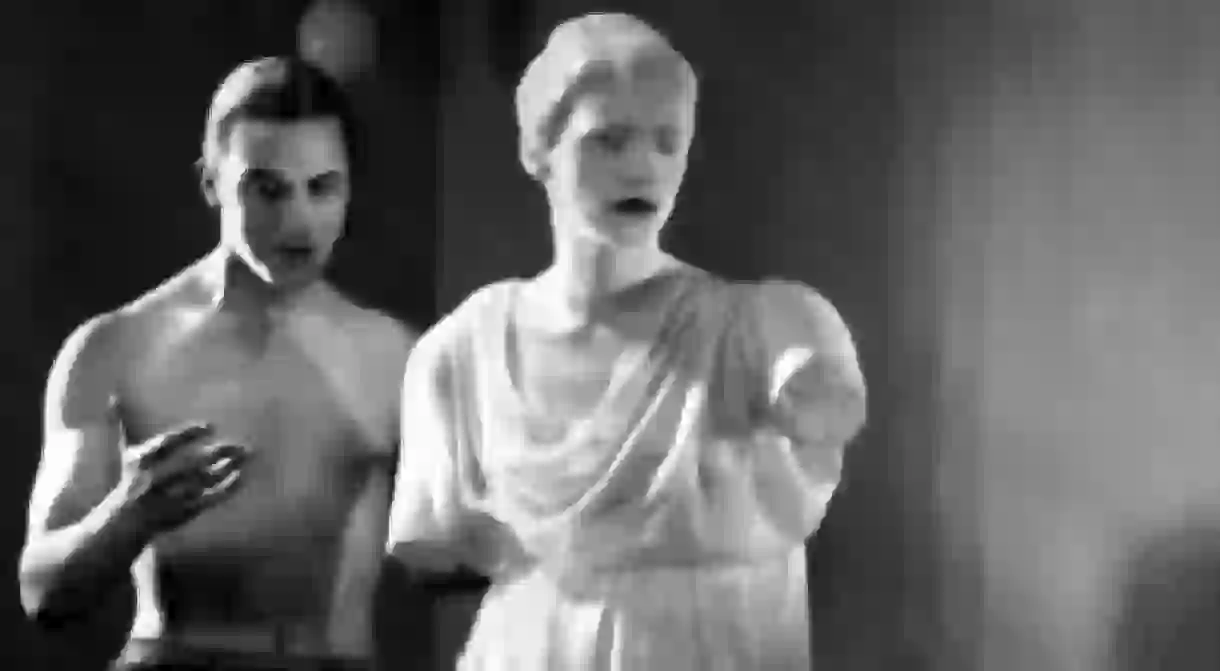Jean Cocteau, The Poetic Prince of French Cinema

Jean Cocteau stands alongside figures like Germaine Dulac, Luis Buñuel, and Salvador Dali as one of cinema’s most influential Surrealists. Here, we pay special attention to his three most important films.
One of the greatest figures of the 20th century and one of its most versatile artists, Jean Cocteau was a true master of the Surreal. Cocteau possessed many different talents in the arts and was skilled at poetry, painting, drawing, filmmaking, and acting.
He was perhaps most widely recognized for the films he directed in his lifetime, especially The Blood of a Poet (Le Sang d’un Poete, 1930), Beauty and the Beast (La Belle et la Bête, 1946), and Orphée (1950).
These three films remain the pillars of his visual style. The latter film was especially significant since Cocteau often dealt with the theme of Orpheus in his life and in his art. He was an artist who idealized classicism such as Greek mythology, embraced modernist forms, such as Cubism and jazz, and anticipated postmodernist dilemmas without losing sight of his own creative identity and of art’s unique ability to inform and enhance human life.
Jean Cocteau was born in Maisons-Lafitte on July 5, 1889. He grew up in nearby Paris, in a wealthy bourgeois family. Due to his family’s standing in society, Cocteau was able to reap the rewards of the privileged life of the upper classes. This included exposure to the arts and theater at a young age.
Cocteau’s artistic career flourished during the two world wars. His first major successes were his stage play, Orphée, and his novel, Les Enfants Terrible. In 1929, Cocteau made his first major film, The Blood of a Poet, at age 41. By then he had dedicated nearly 25 years to writing, theatrical productions, stage design, murals, and drawings.
The Blood of a Poet is divided into four episodes, some more connected than others. The most famous of these features the eponymous poet moving along a corridor in a hotel, looking through the keyholes of bedroom doors. Through these keyholes, he spies a range of tableaux vivants.
These include a bedroom in which a child annoys a governess by crawling up a wall, a Mexican firing squad in which the victim falls to the ground and then bounces back to life, and a dark space in which a couple write observations about each other while they embrace. Themes and images that present themselves in this film recur in Cocteau’s future projects, such as mirrors, eyes, statues, doors, and blood.
In 1946, Cocteau directed his first narrative film, The Beauty and the Beast, based on the famous children’s story by Madame Leprince de Beaumont. With this film, Cocteau reached a new level of artistic fusion, combining mythical narrative, visual poetry, cinematic trickery, and even his own child-like writing in the credit sequence. The episodic, self-consciously experimental style of The Blood of a Poet was left far behind.
Cocteau’s claim that it was Beauty and the Beast that forced him to return to film may not be wholly convincing, but it does give a sense of his close identification with de Beaumont’s writing. In particular, her visual vocabulary — mirrors, doors, horses, and jewelry – is extremely similar to Cocteau’s own vocabulary. As a result of these similarities, Cocteau seamlessly integrates her imagery into his cinematic world.
Orphan is the film that is thought to encapsulate Cocteau’s life and work. Loosely based on his 1925 stage play, it is a culmination of Cocteau’s artistic development, the ultimate merging of his preoccupations with mythology, melodrama, and fantasy into a unified whole.
The film begins in a scene reminiscent of Cocteau’s youth: a group of adoring young poets sits in a café, discussing art. They begin to argue and eventually have to be separated by riot police. Suddenly, a young poet called Cégèste is run down by two passing motorcyclists. He is taken into a limousine by a woman who claims to be his guardian. She insists that Orphée, an older poet also present at the cafe, accompany her.
What follows is the ultimate Cocteau mixture of myth and autobiography, a fantastical story of demise and rebirth, erotic obsession, and travels through the afterlife. The film resurrects a number of figures from Cocteau’s previous works, most notably Orphée, Cégèste, and the Heurtebise. It balances many of Cocteau’s favorite images such as magic gloves and the mirror, with realistic details and wartime iconography.
As in The Beauty and the Beast, Cocteau’s cinematic deceit is unassuming and subsumes itself to the demands of the narrative. In the film, as Orphée puts on the pair of gloves that will allow him to walk through mirrors, the use of reverse-motion leads to the impression that they mould themselves to his hands through some supernatural force.
When Orphée and Heurtebise make their final voyage into the afterlife, Cocteau again uses the technique of placing the back wall of the set on the floor and filming from above, so creating a sense of displaced gravity. However, this time he uses this trick discreetly, not as the self-conscious expression of filmmaking boldness that it was in The Blood of a Poet but as a means of communicating the disorientating otherness of the afterlife.
Cocteau died on October 11, 1963, in Milly-la-Foret, at the age of 74, leaving behind seven films that have become French institutions. Though these films represent a small part of his artistic career, they reveal the most about him. He was not restrained in his work by the limitations of imagination or convention. His passion shows in every aspect of his film, from the outstanding writing, to the imaginative set design, and, of course, the innovative and poetic directing.













